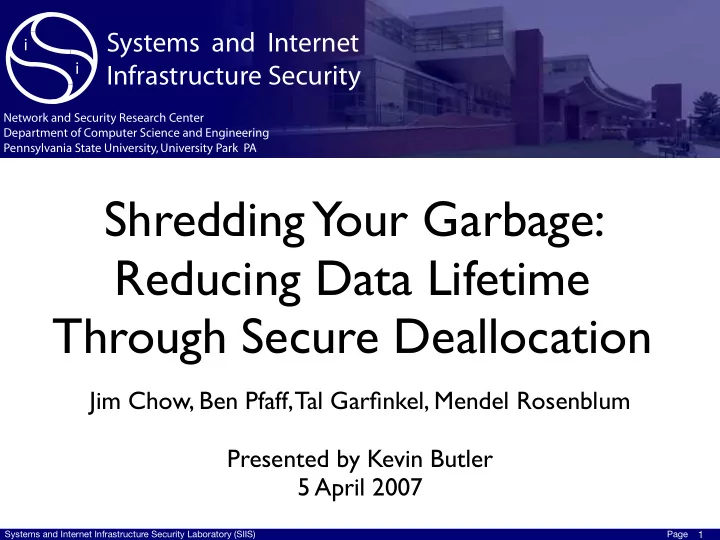

�������������������������������������������� ������������������ ���������������������� � � �������������������������������� ����������������������������������������� Shredding Your Garbage: Reducing Data Lifetime Through Secure Deallocation Jim Chow, Ben Pfaff, Tal Garfinkel, Mendel Rosenblum Presented by Kevin Butler 5 April 2007 Systems and Internet Infrastructure Security Laboratory (SIIS) Page 1
Where Does Data Go to Die? • Old but sensitive data permeates systems ‣ Throughout user and kernel space • How long does this data sit around for? ‣ Seconds? Minutes? Hours? Days? Weeks? • What are the implications of all this sensitive data being accessible past the end of its useful life? • How do we get rid of it? Systems and Internet Infrastructure Security Laboratory (SIIS) Page 2
Data Leakage • Direct compromise of a system • Software bugs that leak memory • Unintended interactions (dumps, logs, etc.) • Accidental reuse of data (dirty pages) • Unanticipated leaks to disk or NAS • Applications! ‣ For the most part, not designed to deal with sensitive data ‣ OSes, libraries, runtimes have problems Systems and Internet Infrastructure Security Laboratory (SIIS) Page 3
Life Cycles of Data • What is a life cycle when talking about data? • Ideal: First write after allocation to last read before deallocation • Natural: First write after allocation to first write after next allocation • Secure Deallocation: First write after allocation until explicit deallocation Systems and Internet Infrastructure Security Laboratory (SIIS) Page 4
Undead Data • Why does some data stick around? • Effects ‣ data still around 1-2 weeks after last usage • Holes caused by slab allocator ‣ Another term for this? • Warm vs. cold reboot ‣ How is memory affected? ‣ Why does a ThinkPad act differently? Systems and Internet Infrastructure Security Laboratory (SIIS) Page 5
Secure Deallocation • What is the process? ‣ Zero out sensitive information when it’s finished being used • Where is the best place to do deallocation? ‣ Every layer! ‣ Applications: Best knowledge of where sensitive data is and when to clean it; complex and laborious to identify all spots for deallocation ‣ Compilers: Static requests vs. Libraries: dynamic requests ‣ OS: final spot where clearing can be done Systems and Internet Infrastructure Security Laboratory (SIIS) Page 6
How to Clear Data • In compilers/libraries: ‣ free call zeroes allocated heap data ‣ on stack, zero activation frames or all data below SP • In kernel: ‣ use semantic info to selectively clear structs ‣ user space memory, I/O buffers ‣ zeroing large areas of memory (e.g., pages) has performance tradeoffs ‣ what is this similar to? Systems and Internet Infrastructure Security Laboratory (SIIS) Page 7
Results • Secure deallocation makes data last about 1.3 times longer on average than ideal case but much less time than natural lifetime would be ‣ e.g., Mozilla: 11s ideal, 21s secure, 40s natural ‣ Thunderbird: 5s ideal, 10s secure, 34s natural • Anything pop out at you looking at the results? • Kernel clearing strategies: < 7% overhead for heap clearing, <2% for stack clearing ‣ but if stack clearing needs to be done right after allocation, overhad between 10-40% Systems and Internet Infrastructure Security Laboratory (SIIS) Page 8
What Next? • Problem identified, mechanisms created for solving the problem • What would your next paper be? ‣ apply to different domains (VMMs, programming language runtimes) ‣ go lower: build into OS (or hardware? ephemeral mem) ‣ Consider effect of new technologies (NVRAM?) ‣ parameterize and tune algorithms ‣ expand aspect of work (rather than C, look at GC languages) Systems and Internet Infrastructure Security Laboratory (SIIS) Page 9
Takeaway • Insight: many (most) applications don’t think about security (even those that explicitly deal with it) • Minimize reliance on users/coders who will make bad decisions... minimize complexity to them • Defence in depth (many things may need modification to ensure complete coverage) • I like puppet shows Systems and Internet Infrastructure Security Laboratory (SIIS) Page 10
Recommend
More recommend